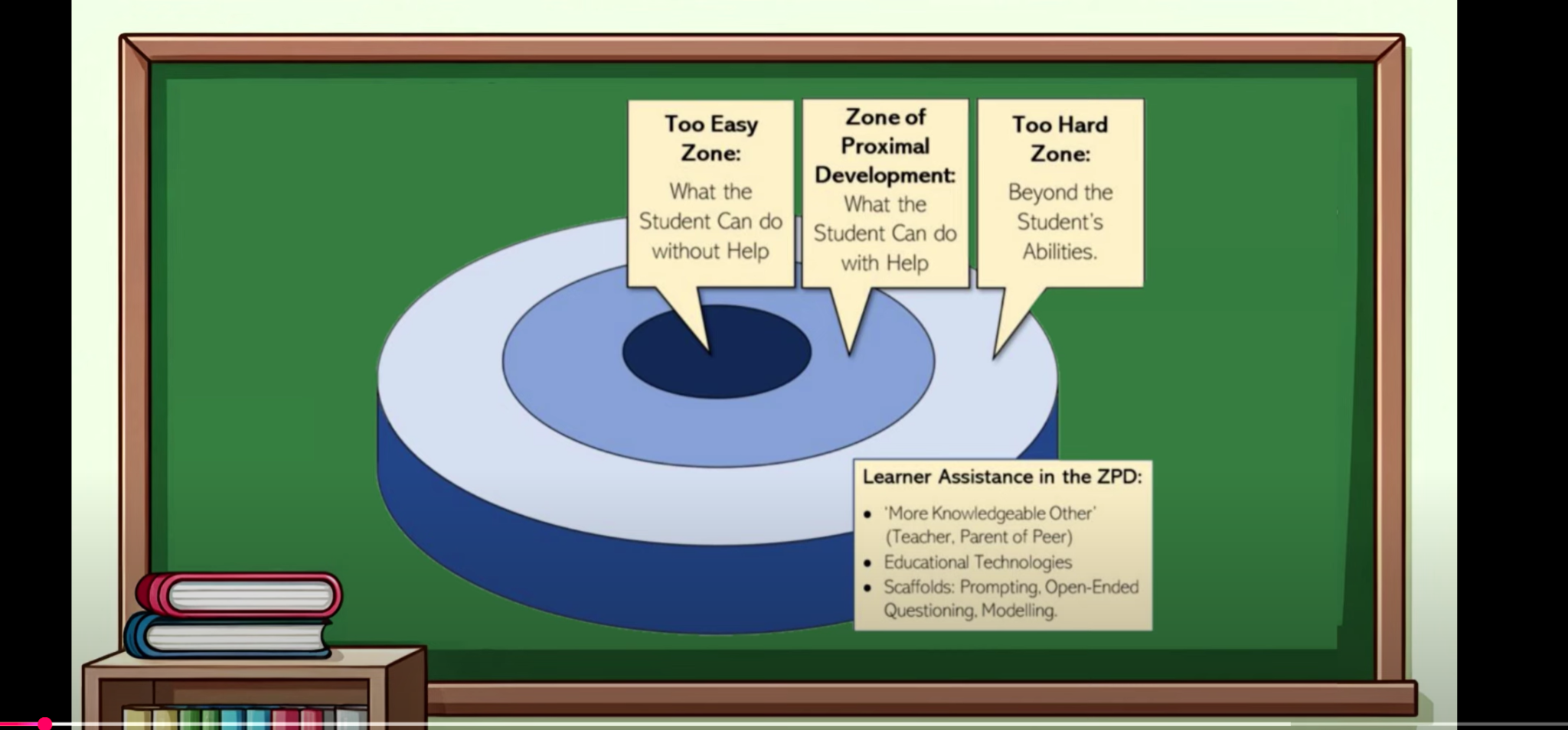Post#3 The theoretical foundation of the “facilitator” role in education.
After observing the behavior of teachers at Coursera and Outschool last week, I got to thinking:
- What does it mean to be a “facilitator” in education?
- What theories support this shift from traditional teaching?
This week, I paused my observations to explore two key resources that helped me clarify the theoretical dimensions of this shift.
1. Vygotsky’s Zone of Proximal Development (ZPD)
In a short but meaningful YouTube video, I learned how Vygotsky described the zone of proximal development (ZPD) as the gap between what learners can do independently and what they can do with the help of others. Vygotsky divides learning tasks into three zones:
- What the learner can do independently
- What the learner cannot do, even with the help of others
- ZPD = what the learner can do with the support of more knowledgeable others
The role of the teacher, or the more knowledgeable other, is to provide “scaffolding” to help learners move beyond their current abilities. Learning is most effective in this zone because the task is neither too easy nor too challenging. It emphasizes the importance of social interaction, especially with tutors or peers, in promoting cognitive development. The role of the teacher should be proactive in designing instructional tasks so that they are within the ZPD, allowing students to learn efficiently.
This theory aligns well with the idea of the facilitator: the facilitator does not provide answers, but rather guides thinking and problem solving, and then steps back as the learner grows.
2. Teacher Presence in Online Learning – Barnes
This article provided in class, I thought would be very helpful for my research topic. Barnes’ article, “Where Are the Teachers? provides a powerful framework for thinking about the invisible but vital presence of teachers in online education. She argues that presence is more than just “being seen”; it is a pedagogical intention. “Teacher presence means more than being visible; it means having a pedagogical intent.” Barnes (2016)
She describes three types of presence: social presence, cognitive presence, and pedagogical presence. Good facilitators are able to create opportunities for learners to communicate, reflect, and construct meaning, even if they are not always speaking. This expanded my understanding of “teaching” far beyond lectures – teaching is about the design of the learning experience. “When there is a lack of instructor guidance, students can lose their way, become distracted, and struggle to connect ideas.” Barnes (2016)
This week has deepened my understanding of what it really means to be an educational facilitator. Through Vygotsky’s concept of the “zone of proximal development,” I have learned that effective teaching is not just about giving answers, but about providing the right amount of support for learner growth. Barnes (2016) expanded on this concept by stating that a teacher’s presence does not depend on visibility but rather on intentional design, guidance, and creativity.
-
Barnes, C. L. (2016). Where’s the teacher? Defining the role of instructor presence in social presence and cognition in online education. In J. J. Stommel & S. Morris (Eds.), Humanizing online teaching and learning. Retrieved from https://humanmooc.pressbooks.com/chapter/wheres-the-teacher-defining-the-role-of-instructor-presence-in-social-presence-and-cognition-in-online-education/
-
Helpful Professor Explains. (2021, Apr 7). Vygotsky’s Zone of Proximal Development (ZPD) explained in 4 minutes [Video]. YouTube. https://www.youtube.com/watch?v=sYF5HefF6wA



Hello Dylan!!
I enjoyed reading through your blog post and I liked that you broke it up into two separate sections, it keeps the information organized while influencing flow. in the first half, I appreciate that you explained the role of the facilitator as I feel that it is often misunderstood. Is there a specific role that you prefer to take on during group projects?
Moving onto your second part, I think it is important that you embedded a video in your post as it enhances the information you shared about the teachers presence in online learning.
Thank you for your effort, I learned a lot through your work!
Thank you so much for the compliments! I’m glad my structure was appropriate – I had hoped to stay organized and not compromise the overall flow, so that means a lot to me.
You’re absolutely right that the facilitator role is often misunderstood or treated as if it doesn’t care, when in reality it takes a lot of heart and time to conceptualize the whole process. For group projects, I prefer to help everyone stay on track while making sure everyone’s voice is heard. I find that asking good questions and providing space for everyone’s input often leads to the best ideas.